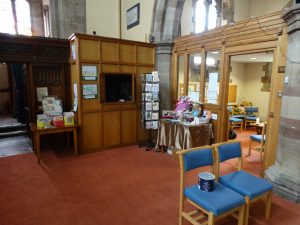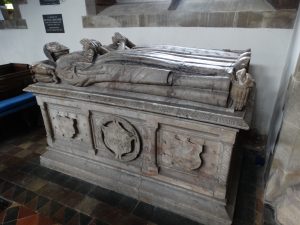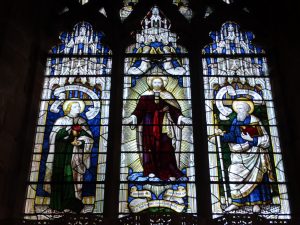St Peter’s church, Yoxall, in on the busy main road – SK 142190. They have a website, but don’t seem to have a Vicar at the moment. We parked in the pub car park – lovely flowers, we must go back for a meal – website.
 The church was open, with some friendly people. Nice “Discovering Yoxall” leaflet from the parish council, with a walk around the village.
The church was open, with some friendly people. Nice “Discovering Yoxall” leaflet from the parish council, with a walk around the village.
Bright sun for the photos, and a welcoming notice! Traditionally the church is Saxon, but there is no evidence for this, and no mention in the Doomsday Book. The capital and arch of the South Door date to about 1200, but as we enter by the North Door, I failed to photo it. The first named Vicar is Roger de Yoxall, circa 1241. In 1533 there existed a chantry chapel endowed at some unknown date by Robert Rose, and two chantry priests, Richard Rauynstall and Thomas Mason are named in wills of the period. In 1547 the churchwardens’ accounts state “It(em) the costs at the takynge downs the images xijd”, and six years later (after the accession of Mary) “It(em) payd fr the rde and the ymages and to the clerke for settynge them upper ixs.vd”. As we can see, the rood screen was taken down again.
They did some work at the back of the church, with St Swithin’s room in 2002, and I like the sign reminding the choir to behave as they enter church. Some nice banners – a bit different to what is normal.
When Humphrey Welles’ died in 1564 he specified that his body should be buried in an alabaster tomb between the pillars that stood between the body of the church and the Lady Chapel. The tomb is probably the work of Boyleys, a Burton firm of tomb-makers, and was moved to its present position in the restoration of the 1860s. I have very rarely thought about who actually makes tombs, who has the skills to carve in alabaster.
There is a memorial to Admiral Henry Meynell, although I can’t find anything in the guide about him. He died in 1865, and I assume it the same admiral whose portrait is in Leeds Art Gallery – website. According to the listing statement for the church – website – the tomb is by Baron Marochetti. You can find out about him here – what did we do before google? He also did the statue of Richard the Lionheart that stands outside the House of Lords.
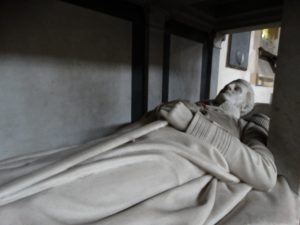 There is a plaque to James Thompson, VC. He was awarded his VC during the Indian Mutiny – there is information here. “For gallant conduct in saving the life of his captain (Captain Wilton), on the 9th of July, 1857, by dashing forward to his relief, when that officer was surrounded by a party of Ghazees, who made a sudden rush on him, from a serai – and killing two of them before further assistance could reach. Also recommended for conspicuous conduct throughout the siege.”
There is a plaque to James Thompson, VC. He was awarded his VC during the Indian Mutiny – there is information here. “For gallant conduct in saving the life of his captain (Captain Wilton), on the 9th of July, 1857, by dashing forward to his relief, when that officer was surrounded by a party of Ghazees, who made a sudden rush on him, from a serai – and killing two of them before further assistance could reach. Also recommended for conspicuous conduct throughout the siege.”
An interesting War Memorial and window, though I don’t know who made either of them, and please can we remove the Christmas lights.
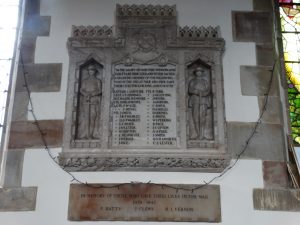
 Some of the other glass is William Wailes.
Some of the other glass is William Wailes.
This altar and alabaster reredos was added in 1917 – and that’s all the guide tells me.
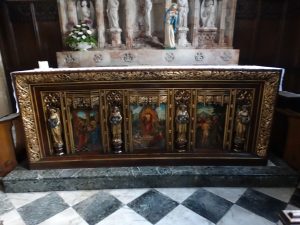 Nor does it tell me anything about the clock. I can’t think of another church where the face is simply painted on the tower. I could go back through this blog and see … or not.
Nor does it tell me anything about the clock. I can’t think of another church where the face is simply painted on the tower. I could go back through this blog and see … or not.





